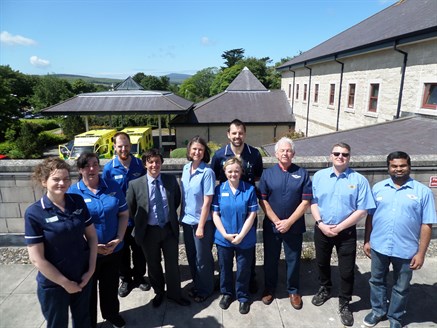
The Isle of Man air ambulance transfers people to the UK for a huge range of medical reasons all year round – but it is placed under intense pressure when the Island is at its busiest during TT fortnight.
Training sessions were held during April and May to prepare the team ahead of the festival.
And extra staff were placed on duty during the event to transfer those patients who had suffered major trauma – defined as multiple broken bones, serious spinal injuries, brain injuries or life-threatening damage to internal organs – as well as the air ambulance’s usual workload.
During this year’s event, 25 people were transferred off-island, of which 11 had sustained trauma. A number of patients who had completed treatment in the UK were transferred back to Noble’s Hospital for on-going care.
The helicopters that attend incidents to treat sick and injured people on the Island do not transport them to Liverpool across the Irish Sea. Civil Aviation Authority regulations mean that only helicopters which are specially-adapted can be used for medical flights over water.
Instead, all off-island transfers are completed by the Isle of Man air ambulance service, which uses a small plane based at Ronaldsway through current service provider Woodgate Aviation. Best described as a flying intensive care unit, it can accommodate two patients and two health care staff.
A re-organisation of services for major trauma patients took place across the UK between 2009 and 2012.
In the UK, an ambulance transporting a major trauma patient from the scene of their injury will drive past the local hospital to reach a major trauma centre. On the Island, however, all cases are assessed and stabilised at the emergency department at Noble’s Hospital before a decision is made over the need to transfer to the Island’s major trauma centre, which is in Aintree, Liverpool.
The majority of people who sustain an injury will receive all their treatment at Noble’s – but those who meet certain criteria are flown to Aintree.
More than 500 patients are transferred each year between the Island and the UK. As well as major trauma incidents, the service also looks after people requiring specialist care only available elsewhere – for example, someone who has had a heart attack and needs to be taken to Liverpool for an angiogram.
The nurses, paramedics and doctors who work for the air ambulance service are staff at Noble’s Hospital and a contracted road ambulance service in Liverpool is always waiting to complete the patient transfer on landing. The task of planning and organising transfers is done by the air ambulance co-ordinator, who is based at Noble’s and is on-call 24 hours a day.
The equipment carried on board offers some indication of the level of care available to anyone who may need to be taken across for treatment.
The aircraft carries a large tank of oxygen and has an AC power supply. Patients can be sedated on a portable ventilator and staff are able to monitor a person’s condition to the same high standard as that on an intensive care unit.
Should it be required, a defibrillator is available to restart a patient’s heart during transfer, while blood transfusions can be carried out and drugs used to control blood pressure and improve blood supply to the brain.
TT is undoubtedly its busiest period, but the Isle of Man air ambulance service works every day of the year to make sure sick or injured people receive the specialist care they need.
By Kate Teare, Consultant Anaesthetist and Medical lead for the air Ambulance Service.

